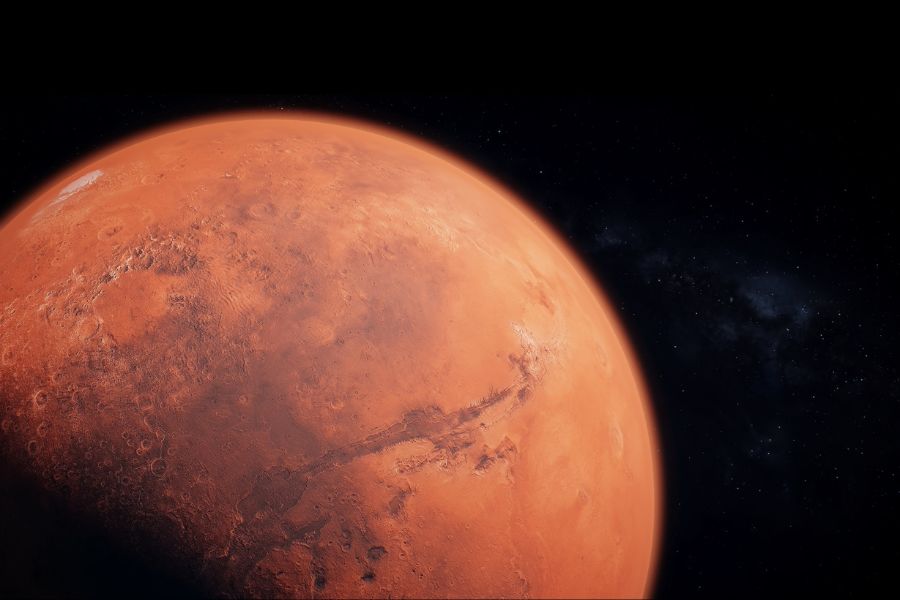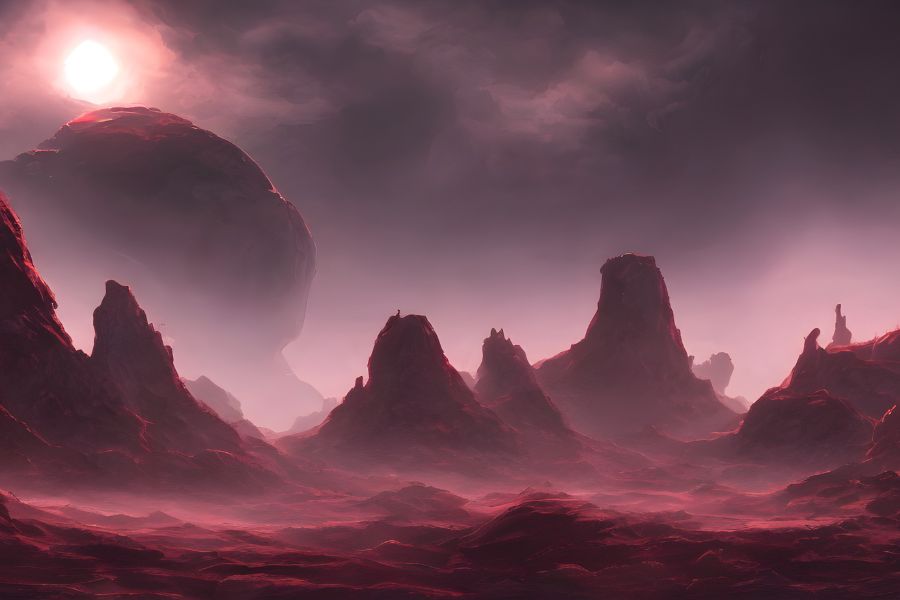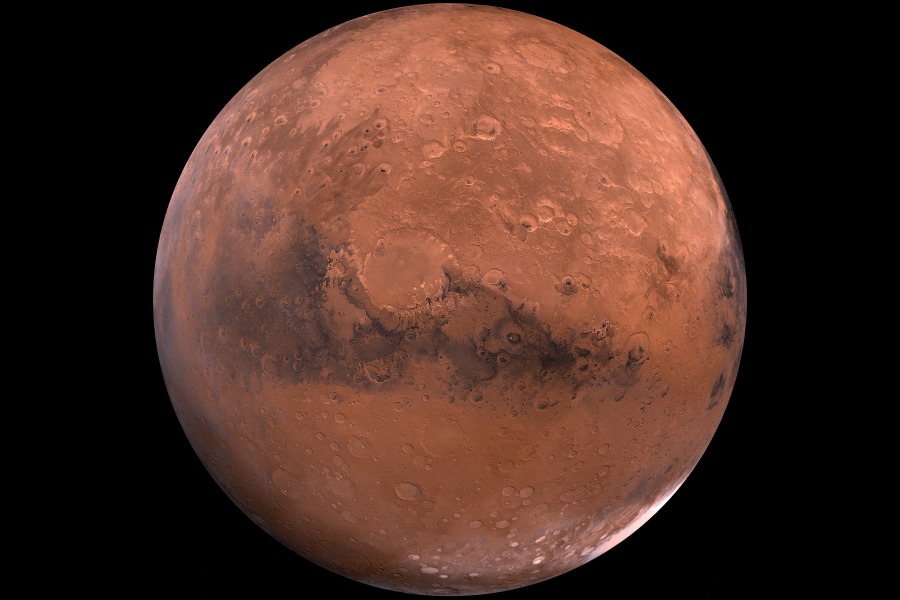Mars, the enigmatic Red Planet, has fascinated humanity for centuries. Its rusty surface, captivating landscapes, and potential for extraterrestrial life have kept us gazing skyward in wonder. However, amid all the intrigue, a fundamental question persists: Is Mars truly a planet?
The ancient civilizations that first observed Mars in the night sky had no doubt about its status as a planet. To them, “planet” meant a wandering star, a celestial body that moved differently from the fixed stars. Mars’s distinct motion across the backdrop of stars was unmistakable.
So, is Mars a planet? We will delve into the complexities of this cosmic puzzle, exploring the historical journey of how we’ve come to understand Mars and the evolving definitions of what constitutes a planet in our ever-expanding universe.
Is Mars a Planet?
While it may seem like an obvious “yes” to many, the status of Mars as a planet has been debated and reevaluated in recent years. In 2006, the International Astronomical Union (IAU) established a set of criteria to define what constitutes a planet. This led to a reexamination of the classification of celestial bodies within our solar system, including Mars.
So, Mars is indeed a planet. The International Astronomical Union (IAU) defines a planet by three criteria: orbiting the Sun, sufficient mass for a nearly round shape, and clearing its orbital neighborhood.
Mars meets these criteria; it orbits the Sun, has a round shape, and influences its surroundings, making it an undeniable planet in our solar system. Mars is undoubtedly a planet, as defined by the International Astronomical Union’s criteria.
How does Mars meet the first two criteria?
Mars unquestionably meets the first two criteria. It orbits the Sun, following an elliptical path that brings it closer to and farther from our star in a predictable pattern. Its spherical shape is evident through telescopic observation and spacecraft imaging. Due to its self-gravity, Mars’s size and mass are sufficient to maintain a round shape.
The contentious third criterion
The third criterion has sparked debates and rekindled the question of Mars’s planetary status. Mars, like Earth, shares its orbital neighborhood with numerous asteroids and other celestial objects. Critics argue that no planet in the solar system, including Earth, completely “clears the neighborhood” of debris.

The Historical Perspective
Mars, with its distinct reddish appearance, has been a celestial object of interest for millennia. Ancient civilizations, including the Egyptians and Babylonians, observed and recorded its movements in the night sky. These early astronomers recognized Mars as one of the wandering stars, or planets, visible to the naked eye.
Transformation of planetary understanding with Kepler and Galileo
The 17th century marked a significant turning point in our understanding of Mars and the planets. Johannes Kepler’s laws of planetary motion provided mathematical descriptions of the planets’ orbits, including Mars.
Galileo Galilei’s telescopic observations of Mars revealed its phases, much like those of Venus and the Moon, supporting the idea that Mars orbited the Sun. These revolutionary insights into planetary motion and observation confirmed Mars’s status as a planet in our solar system.
How Is Mars Different From Earth?
Size and Mass
Mars is approximately 6,779 kilometers (4,212 miles) in diameter, compared to Earth’s 12,742 kilometers (7,918 miles). It has approximately 38% of Earth’s gravity.
Atmosphere
Mars’ thin atmosphere is about 95% carbon dioxide, with trace amounts of other gases like nitrogen and argon. On the other hand, Earth’s atmosphere is predominantly composed of nitrogen (about 78%) and oxygen (about 21%), with small amounts of other gases.
Surface conditions
Mars has a barren landscape with deserts, canyons, and polar ice caps. Also, surface temperatures on Mars can range from extremely cold to relatively mild. However, Earth has diverse ecosystems, oceans, forests, and climates.
Water
Mars has water in the form of ice at polar caps and possibly underground. Liquid water is scarce on Mars due to low atmospheric pressure. In contrast, Earth has abundant liquid surface water.
Magnetic field
Mars lacks a global magnetic field, exposing its surface to harmful radiation. When it comes to Earth, its strong magnetic field provides protection from radiation.
Moons
Phobos and Deimos are Mars’ two small moons. On the other hand, a large moon orbits Earth.
Climate
Mars has a harsher and more extreme climate than Earth. It experiences dust storms, frigid temperatures, and lacks liquid surface water. In comparison, Earth has a moderate and stable climate with diverse weather patterns.
Potential for life
- Scientists actively explore Mars for signs of past or present microbial life. However, Earth supports various life forms.

What Are the Characteristics of Mars?
Mars’s surface
Mars’s surface has geological features that have sparked the curiosity of scientists and space enthusiasts for decades. Some notable aspects of Mars’ surface include:
- Mountains – Olympus Mons, the largest volcano in the solar system, stands proudly on Mars. It soars to a staggering height of about 69,841 feet (21.287 kilometers), dwarfing Mount Everest on Earth.
- Canyons – The Valles Marineris canyon system stretches over 2,500 miles (4,000 kilometers) and plunges to depths exceeding 7 miles (11 kilometers), far surpassing the Grand Canyon’s dimensions. These canyons bear witness to Mars’ turbulent geological past.
- Deserts – Vast, rust-colored deserts dominate the Martian landscape. The iron oxide-rich regolith gives the planet its distinctive reddish hue.
- Polar Ice Caps – Similar to Earth, Mars has polar ice caps. Its polar caps consist of water ice and dry ice (frozen carbon dioxide). These caps grow and recede with the changing seasons on Mars.
- Impact Craters: Mars is pockmarked with numerous impact craters, remnants of cosmic collisions over eons. Studying these craters helps scientists unravel the planet’s geological history.
Water
Mars has water, primarily in the form of ice. The planet’s polar ice caps contain a substantial amount of water ice. Additionally, there’s strong evidence of underground water ice reservoirs. However, liquid water is rare on the surface due to Mars’ low atmospheric pressure and frigid temperatures. Any surface water would quickly freeze or evaporate.
Moons
Mars is accompanied by two diminutive moons: Phobos and Deimos. These tiny moons, irregular in shape, are vastly different from Earth’s moon. Scientists believe they are captured asteroids from the asteroid belt between Mars and Jupiter. Phobos is the larger of the two and orbits Mars at an exceptionally close distance.
Atmospheric composition (by volume)
Mars boasts an atmosphere, albeit thin compared to Earth’s. It mainly consists of carbon dioxide, making up approximately 95% of its composition.
Nitrogen and argon make up the remaining components, although they are present in trace amounts. The thin atmosphere contributes to Mars’s challenges as a habitable planet, as it cannot effectively retain heat or shield against harmful radiation.
Magnetic field
Mars lost its global magnetic field billions of years ago, marking a pivotal moment in its geological history. The reasons for this magnetic demise are complex but are largely attributed to Mars’s smaller size and cooling core.
As the core solidified, it could no longer generate a strong magnetic field, exposing Mars to the harsh solar and cosmic radiation that has shaped its surface and atmosphere.
Internal structure
Mars shares some structural similarities with Earth, with an internal division into a core, mantle, and crust. However, there are significant differences. Mars’s core is considered partially molten but smaller than Earth’s core. The reduction in size and molten activity contributed to the weakening and eventual loss of Mars’ global magnetic field.
Understanding Mars’s internal structure provides valuable insights into its geological evolution, including the formation of its vast volcanoes, canyons, and impact features. It also sheds light on the factors influencing its surface conditions and potential habitability.
Is There Any Martian Exploration?
Robotic missions
Robotic missions to Mars have played a pivotal role in our quest to understand the Red Planet. These missions have allowed us to explore Mars’s surface, study its geology, and search for past or present life signs.
Notable missions include the Mars rovers, such as Spirit, Opportunity, Curiosity, and Perseverance, which have provided valuable data and stunning images of the Martian landscape. These robotic explorers have also been instrumental in studying Mars’ climate, atmosphere, and potential for future human missions.
The search for signs of past or present life
One of the primary objectives of Martian exploration is the search for signs of life. While no direct evidence of current life has been found, intriguing discoveries have been made.
For instance, the presence of water ice, seasonal methane fluctuations, and the existence of ancient river valleys and lake beds suggest that Mars may have had the conditions necessary for life in the distant past.
However, scientists continue to analyze Martian rocks and soils for potential biosignatures that could shed light on Mars’s microbial history.
Future manned missions to Mars
The dream of sending humans to Mars has captured the imagination of space enthusiasts and scientists alike. Several space agencies and private companies are actively working on plans for future manned missions to Mars. SpaceX’s Starship and NASA’s Artemis program are among the ambitious projects to make this dream a reality.

These missions would mark a significant leap in human space exploration, with astronauts conducting experiments, establishing colonies, and furthering our understanding of the Martian environment.
The Search for Extraterrestrial Life
The possibility of life on Mars is a compelling question that has fueled scientific investigations for decades. Mars’s history suggests it may have once had conditions suitable for life, including liquid water and a more substantial atmosphere.
Today, the search for life on Mars focuses on microbial organisms that may exist deep underground, where water could still be in liquid form. Additionally, extremophiles on Earth have expanded our understanding of life’s adaptability, making the quest for Martian life all the more intriguing.
Astrobiology and the search for Martian microbes
Astrobiology, the study of life beyond Earth, is at the forefront of Martian exploration. Researchers are developing specialized instruments to search for signs of microbial life in Martian soils and subsurface environments.
The concept of “Follow the water” guides these investigations, as water is a fundamental requirement for life as we know it. Recent discoveries of subsurface lakes and the detection of organic molecules on Mars have bolstered hopes that Mars could hold the keys to unlocking the mysteries of extraterrestrial life.
The role of Mars in the search for life beyond earth
Mars plays a unique role in the broader search for life beyond Earth. Its proximity, geological history, and potential habitability make it a compelling target for astrobiological research.
Success in finding life on Mars, even in the form of microorganisms, would have profound implications for our understanding of life’s prevalence in the universe. It would bolster the idea that life could exist elsewhere in our solar system and beyond, sparking new questions and expanding the horizons of our cosmic exploration.
Frequently Asked Questions
Did Mars used to be like Earth?
Mars has a fascinating geological history that suggests it may have once been more Earth-like. Geological evidence, such as ancient river valleys, lake beds, and minerals that require liquid water to form, strongly indicate that Mars had a much warmer and wetter past.
Mars may have had a more Earth-like climate billions of years ago, with a thicker atmosphere, rivers, and even oceans. However, its atmosphere thinned over time, and the surface water largely disappeared, turning it into the cold, arid planet we see today.
Is Mars a terrestrial planet?
Yes, Mars is classified as a terrestrial planet. Terrestrial planets, also known as rocky planets, share several key characteristics: they have solid, rocky surfaces, relatively thin atmospheres compared to gas giants, and they orbit relatively close to the Sun.
In our solar system, the terrestrial planets include Mercury, Venus, Earth, and Mars. These planets are distinct from the gas giants, such as Jupiter and Saturn, primarily composed of gas.
What criteria does the IAU use to classify celestial bodies as planets?
The International Astronomical Union (IAU) has established three criteria for classifying celestial bodies as planets:
- The celestial body must orbit the Sun.
- The celestial body must be spherical in shape.
- The celestial body must have cleared its orbit of other debris.
Mars meets the first two criteria as it orbits the Sun and has a nearly spherical shape. However, the third criterion has been a subject of debate and is one reason why there have been discussions about whether Mars qualifies as a planet. Currently, Mars continues to be recognized as a planet within our solar system.
Conclusion
Mars has long fascinated humanity and faced debates over its planetary status. And, we have delved into the complex classification of planets. So, is Mars a planet?
From ancient civilizations to modern criteria defined by the International Astronomical Union, Mars qualifies as a planet. Its captivating landscapes and potential for extraterrestrial life continue to inspire curiosity.
Our understanding has evolved throughout history, from early views of Mars to Kepler and Galileo’s discoveries. The IAU’s three criteria, met by Mars, confirm its planetary status.
As we gaze at the enigmatic red world, debates notwithstanding, Mars remains a planet. Its enduring allure fuels robotic and potential human-crewed missions. Firmly in our celestial tapestry, Mars beckons us to explore our universe’s mysteries.

